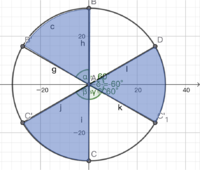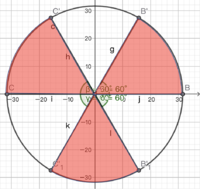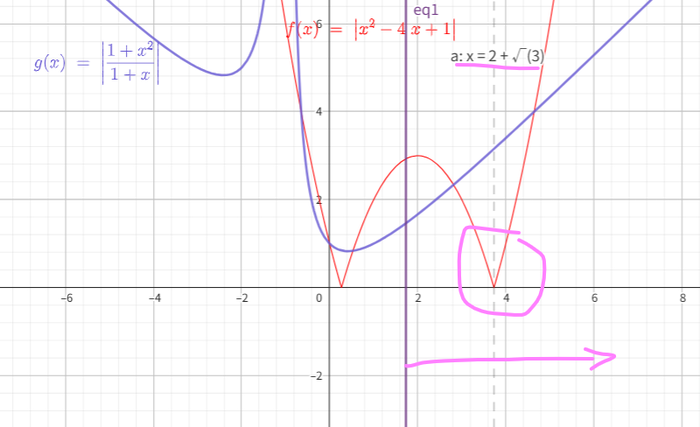2023 AIME I Problems/Problem 15
Contents
Problem
Find the largest prime number ![]() for which there exists a complex number
for which there exists a complex number ![]() satisfying
satisfying
- the real and imaginary part of
 are both integers;
are both integers;  and
and- there exists a triangle whose three side lengths are
 the real part of
the real part of  and the imaginary part of
and the imaginary part of 
Solution
Assume that ![]() . Then,
. Then,
![]() Note that by the Triangle Inequality,
Note that by the Triangle Inequality,
![]() Thus, we know
Thus, we know
![]() Without loss of generality, assume
Without loss of generality, assume ![]() (as otherwise, consider
(as otherwise, consider ![]() ). If
). If ![]() , then
, then
![]() `Thus, this means
`Thus, this means ![]() or
or ![]() . Also note that the roots of
. Also note that the roots of ![]() are
are ![]() , so thus if
, so thus if ![]() ,
,
![]() Note that
Note that
![]() so
so ![]() , and
, and ![]() . If
. If ![]() , then
, then ![]() . Note that
. Note that ![]() , and
, and ![]() , so
, so ![]() or
or ![]() . However, then
. However, then ![]() , absurd.
, absurd.
If ![]() , by similar logic, we have that
, by similar logic, we have that ![]() , so
, so ![]() . However, once again,
. However, once again, ![]() . If
. If ![]() , by the same logic,
, by the same logic, ![]() , so
, so ![]() , where we run into the same problem. Thus
, where we run into the same problem. Thus ![]() indeed.
indeed.
If ![]() , note that
, note that
![]() We note that
We note that ![]() works. Thus, we just need to make sure that if
works. Thus, we just need to make sure that if ![]() ,
, ![]() . But this is easy, as
. But this is easy, as
![]() absurd. Thus, the answer is
absurd. Thus, the answer is ![]() .
.
Solution 2
Denote ![]() . Thus,
. Thus, ![]() .
.
Thus,
![]()
Because ![]() ,
, ![]() ,
, ![]() are three sides of a triangle, we have
are three sides of a triangle, we have ![]() and
and ![]() .
Thus,
.
Thus,
![]()
Because ![]() ,
, ![]() ,
, ![]() are three sides of a triangle, we have the following triangle inequalities:
are three sides of a triangle, we have the following triangle inequalities:

We notice that ![]() , and
, and ![]() ,
, ![]() , and
, and ![]() form a right triangle. Thus,
form a right triangle. Thus, ![]() .
Because
.
Because ![]() ,
, ![]() .
Therefore, (3) holds.
.
Therefore, (3) holds.
Conditions (4) and (5) can be written in the joint form as
![]()
We have
![]() and
and ![]() .
.
Thus, (5) can be written as
![]()
Therefore, we need to jointly solve (1), (2), (6).
From (1) and (2), we have either ![]() , or
, or ![]() .
In (6), by symmetry, without loss of generality, we assume
.
In (6), by symmetry, without loss of generality, we assume ![]() .
.
Thus, (1) and (2) are reduced to
![]()
Let ![]() . Plugging this into (6), we get
. Plugging this into (6), we get
![]()
Because ![]() is a prime,
is a prime, ![]() and
and ![]() are relatively prime.
are relatively prime.
Therefore, we can use (7), (8), ![]() , and
, and ![]() and
and ![]() are relatively prime to solve the problem.
are relatively prime to solve the problem.
To facilitate efficient search, we apply the following criteria:
To satisfy (7) and ![]() , we have
, we have ![]() .
In the outer layer, we search for
.
In the outer layer, we search for ![]() in a decreasing order.
In the inner layer, for each given
in a decreasing order.
In the inner layer, for each given ![]() , we search for
, we search for ![]() .
Given
.
Given ![]() , we search for
, we search for ![]() in the range
in the range ![]() .
We can prove that for
.
We can prove that for ![]() , there is no feasible
, there is no feasible ![]() .
The proof is as follows.
.
The proof is as follows.
For ![]() , to satisfy
, to satisfy ![]() , we have
, we have ![]() .
Thus,
.
Thus, ![]() .
Thus, the R.H.S. of (8) has the following upper bound
.
Thus, the R.H.S. of (8) has the following upper bound

Hence, to satisfy (8), a necessary condition is
![]()
However, this cannot be satisfied for ![]() .
Therefore, there is no feasible solution for
.
Therefore, there is no feasible solution for ![]() .
Therefore, we only need to consider
.
Therefore, we only need to consider ![]() .
.
We eliminate ![]() that is not relatively prime to
that is not relatively prime to ![]() .
.
We use the following criteria to quickly eliminate ![]() that make
that make ![]() a composite number.
a composite number.
- For
 , we eliminate
, we eliminate  satisfying
satisfying  .
.
- For
 (resp.
(resp.  ), we eliminate
), we eliminate  satisfying
satisfying  (resp.
(resp.  ).
).
\item For the remaining ![]() , check whether (8) and the condition that
, check whether (8) and the condition that ![]() is prime are both satisfied.
is prime are both satisfied.
The first feasible solution is ![]() and
and ![]() .
Thus,
.
Thus, ![]() .
.
\item For the remaining search, given ![]() , we only search for
, we only search for ![]() .
.
Following the above search criteria, we find the final answer as ![]() and
and ![]() .
Thus, the largest prime
.
Thus, the largest prime ![]() is
is ![]() .
.
~Steven Chen (Professor Chen Education Palace, www.professorchenedu.com)
Solution 3
Let ![]() .
. ![]() ,
, ![]() .
.
According to the question, ![]() ,
, ![]() , and
, and ![]() construct the side-lengths of a non-degenerate triangle.
construct the side-lengths of a non-degenerate triangle.
![]()
![]()
![]()
This means that the values of ![]() and
and![]() should be limited in coincident areas these two graphs.
should be limited in coincident areas these two graphs.
Also
![]()
![]()
![]()
![]()
![]()
![]()
If ![]() ,
, ![]() , making statement
, making statement ![]() false.
Combining with the former graph depicting possible ranges of
false.
Combining with the former graph depicting possible ranges of ![]() , by loss of generality, we assume
, by loss of generality, we assume ![]() both
both ![]() and exists in the first
and exists in the first ![]() of the circle.
of the circle.
Let ![]() .
.
![]()
![]()
To clearly visualize, we graph out ![]() and
and ![]() separately.
separately.
When ![]() is around
is around ![]() , b reaches its maximum upper bound.
, b reaches its maximum upper bound.
![]()
![]()
![]()
Testing values of ![]() in decreasing order, starting from 8, we test out each corresponding value of
in decreasing order, starting from 8, we test out each corresponding value of ![]() (
(![]() )by trying the two whole numbers closest to the real value of
)by trying the two whole numbers closest to the real value of ![]() .
.
We finally get that ![]() and
and ![]()
~cassphe
Video Solution
~Steven Chen (Professor Chen Education Palace, www.professorchenedu.com)
Video Solution
~MathProblemSolvingSkills.com
Animated Video Solution
~Star League (https://starleague.us)
See also
| 2023 AIME I (Problems • Answer Key • Resources) | ||
| Preceded by Problem 14 |
Followed by Last Problem | |
| 1 • 2 • 3 • 4 • 5 • 6 • 7 • 8 • 9 • 10 • 11 • 12 • 13 • 14 • 15 | ||
| All AIME Problems and Solutions | ||
These problems are copyrighted © by the Mathematical Association of America, as part of the American Mathematics Competitions. ![]()













